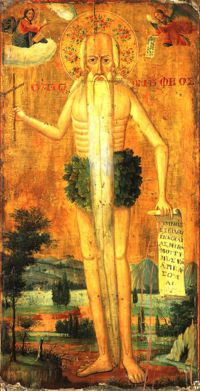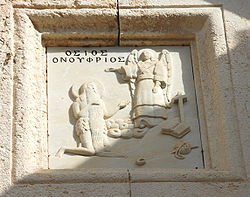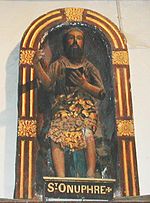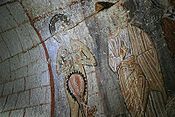- Onuphrius
-
- For the 15th-century papal legate, see Onofrio de Santa Croce.
Saint Onuphrius
Ονούφριος
Icon of Onuphrius. Provenance and date unknown.Born unknown Died 4th or 5th century Honored in Roman Catholic Church
Eastern Orthodox Churches
Oriental Orthodox Churches
Eastern Catholic ChurchesFeast June 12 Attributes old hermit dressed only in long hair and a loincloth of leaves; hermit with an angel bringing him the Eucharist or bread; hermit with a crown at his feet[1] Patronage weavers;[1] jurists[2] Centrache, Italy[1] Onuphrius or Onoufrios (Greek: Ονούφριος, from Egyptian: Wnn-nfr meaning "he-who-is-continuingly-good"[3]), venerated as Saint Onuphrius in both the Roman Catholic Church and Eastern Catholic Churches; Venerable Onuphrius in Eastern Orthodoxy and Saint Nofer the Anchorite in Oriental Orthodoxy, lived as a hermit in the desert of Upper Egypt in the 4th or 5th centuries.[4]
Contents
Life and legends
It is uncertain in which century Onuphrius lived; the account of Paphnutius the Ascetic, who encountered him in the Egyptian desert, forms the sole source for our knowledge of the life of Saint Onuphrius.[4] Even the authorship is uncertain; "Paphnutius", a common name of Egyptian origin in the Upper Thebaid, may refer to Paphnutius of Scetis, a 4th century abbot of Lower Egypt, rather than Paphnutius the Ascetic.[5] "But Paphnutius the Great [i.e. Paphnutius the Ascetic]," Alban Butler writes, "also had a number of stories to tell of visions and miraculous happenings in the desert, some of them in much the same vein as the story of Onuphrius."[5]
A tradition, not found in Paphnutius' account, states that Onuphrius had studied jurisprudence and philosophy before becoming a monk near Thebes and then a hermit.[2] A tradition held by the Eastern Orthodox Church, also not found in Paphnutius' account and similar to the story of Saint Uncumber (Wilgefortis), states that Onuphrius had been a virtuous young girl named Onuphria who, in order not to lose her virginity to a suitor, prayed to become a man -and had her wish miraculously granted.[6][7]
According to Paphnutius’s account, Paphnutius undertook a pilgrimage to study the hermits’ way of life and to determine whether it was for him. Wandering in the desert for 16 days, on the 17th day, Paphnutius came across a wild figure covered in hair, wearing a loincloth of leaves. Frightened, Paphnutius ran away, up a mountain, but the figure called him back, shouting, “Come down to me, man of God, for I am a man also, dwelling in the desert for the love of God.”[4]
Turning back, Paphnutius talked to the wild figure, who introduced himself as Onuphrius and explained that he had once been a monk at a large monastery in the Thebaid but who had now lived as a hermit for 70 years, enduring extreme thirst, hunger, and discomforts. Onuphrius took Paphnutius to his cell, and they spoke until sunset, when bread and water miraculously appeared outside of the hermit's cell.[4]
They spent the night in the prayer, and in the morning Paphnutius discovered that Onuphrius was near death. Paphnutius, distressed, asked the hermit if he should occupy Onuphrius’ cell after the hermit’s death, but Onuphrius told him, "That may not be, thy work is in Egypt with thy brethren."[4] Onuphrius asked Paphnutius for there to be a memorial with incense in Egypt in remembrance of the hermit. He then blessed the traveler and died.[4]
Due to the hard and rocky ground, Paphnutius could not dig a hole for a grave, and therefore covered Onuphrius’ body in a cloak, leaving the hermit’s body in a cleft of the rocks. After the burial, Onuphrius’ cell crumbled, which Paphnutius took to be a sign that he should not stay.[4]
One scholar has written that Onuphrius’ life "fits the mold of countless desert hermits or anchorites... [However] despite its predictability, Paphnutius' Life of Onuphrius is marked by several unique details... the years of Onuphrius' youth were passed in a monastery that observed the rule of strict silence; a hind instructed him in Christian rites and liturgy. During his sixty years in the desert, Onuphrius' only visitor was an angel who delivered a Host every Sunday..."[8]
 Stone carving above the entrance of the Onuphrius monastery in Akeldama, Jerusalem (Potter's field). The image shows Onuphrius bowing down to an angel. Notable features are his long beard, effeminate legs and leaf loincloth.
Stone carving above the entrance of the Onuphrius monastery in Akeldama, Jerusalem (Potter's field). The image shows Onuphrius bowing down to an angel. Notable features are his long beard, effeminate legs and leaf loincloth.
Veneration
Both the Eastern Orthodox and Catholic Churches traditionally mark his feast day on 12 June. A Life of Onuphrius of later Greek origin states that the saint died on June 11; however, his feast day was celebrated on June 12 in the Eastern Orthodox calendars from an early date.
Onuphrius' cult spread across the Middle East, Eastern Europe (including Russia), and Western Europe.
The legend of Saint Onuphrius was depicted in Pisa's camposanto (monumental cemetery), and in Rome, a church, Sant'Onofrio, was built in his honor on the Janiculan Hill in the fifteenth century.[9]
Antony, the archbishop of Novgorod, writing around 1200 AD, stated that Onuphrius’ head was conserved in the church of Saint Acindinus (Akindinos) (Constantinople).[10]
There was a monastery dedicated to him at Jableczna, Poland, dating from at least 1498.[11]
There is a monastery in Jerusalem dedicated to him. The monastery is located at the far end of Gai Ben Hinnom, the Gehenna valley of hell, further it is situated within the site of a Jewish Second Temple cemetery and is built among and includes many typical burial niches common to that period. The monastery also marks the location of Hakeldama, the purported place where Judas Iscariot hung himself.
Saint Onuphrius was venerated in Munich, Basel, and southern Germany, and the Basel humanist Sebastian Brant (who named his own son Onuphrius[12]) published a broadside named In Praise of the Divine Onuphrius and Other Desert Hermit Saints.[12] Onuphrius was depicted in a 1520 painting by Hans Schäufelein.[13]
Art
Images of Saint Onuphrius were conflated with those of the medieval “wild man".[14] In art, he is depicted as a wild man completely covered with hair, wearing a girdle of leaves.[9]
He is depicted Snake Church (Yilanlı Kilise) in the Göreme valley open-air museum in Cappadocia, Turkey.[7][15]
He became the patron saint of weavers due to the fact that he was depicted "dressed only in his own abundant hair, and a loin-cloth of leaves".[1]
He (S. Onofrio) was named co-saint patron of the city of Palermo in 1650.
Name variants
His name appears very variously as Onuphrius, Onouphrius, Onofrius; and in different languages as Humphrey (English), Onofre (Portuguese, Spanish), Onofrio (Italian), etc. In Arabic, the saint was known as Abū Nufar, which, besides being a variant of the name Onuphrius, also means "herbivore."[10]
Folklore
Sicilians pray to Saint Onuphrius when they have lost something. The prayer has many variants but it generally mentions the miraculous properties of Saint Onuphrius' hair . It is widely accepted that repeating the prayer whilst looking for something like keys, a misplaced ring or anything else, will greatly help in finding it sooner.
Notes
- ^ a b c d Patron Saints Index: Saint Onuphrius
- ^ a b lüder h niemeyer: Cornelis Cort, Saint Onuphrius with the Rosary
- ^ See article: Gardiner, A. H. The Origin of Some English Personal Names, Journal of the American Oriental Society, Vol. 56, No. 2. (Jun., 1936), pp. 189-197. (JSTOR or Athens login required)
- ^ a b c d e f g Alban Butler, Paul Burns; Butler’s Lives of the Saints (Continuum International Publishing Group, 2000), 94.
- ^ a b Alban Butler, Paul Burns; Butler’s Lives of the Saints (Continuum International Publishing Group, 2000), 95-6.
- ^ Santa Maria Maggiore
- ^ a b The Hermit St Onuphrius « Travelling Cam
- ^ Peter W. Parshall; Rainer Schoch, National Gallery of Art (U.S.); Origins of European Printmaking (Yale University Press, 2005), 318.
- ^ a b Alban Butler, Paul Burns; Butler’s Lives of the Saints (Continuum International Publishing Group, 2000), 96.
- ^ a b Sant' Onofrio
- ^ Jabłeczna
- ^ a b Peter W. Parshall; Rainer Schoch, National Gallery of Art (U.S.); Origins of European Printmaking (Yale University Press, 2005), 319.
- ^ St. Onuphrius, c.1520 Print & Canvas Art by Hans Leonard Schaufelein | Fine Art Prints | Canvases | Bridgeman Art on Demand
- ^ National Gallery of Art | Press Office
- ^ T.C. Nevşehir Valiliği
See also
External links
- (Italian) Sant’Onofrio
- (Spanish) San Onofre
- (Spanish) San Onofre
Categories:- 4th-century deaths
- Egyptian saints
- Egyptian Roman Catholic saints
- Egyptian hermits
- Transgender topics and religion
- 4th-century Christian saints
Wikimedia Foundation. 2010.


